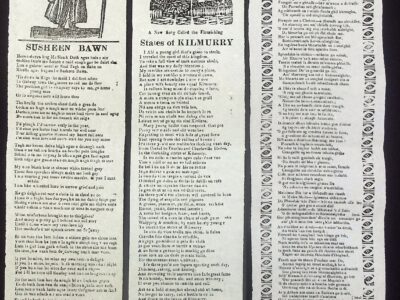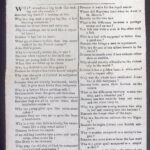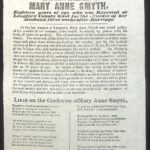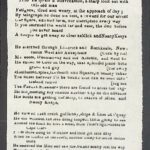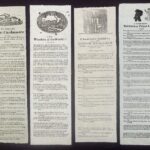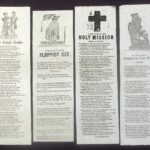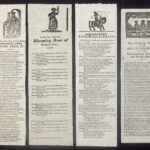Cork Ballads collection
By Jane Haslam, Library cataloguing volunteer, with assistance from Becky Loughead (Librarian)
Ongoing retrospective cataloguing currently being undertaken at the Society occasionally throws up unusual items, including sometimes, those not normally considered to be related to the Society and its works. A small, discrete collection has recently re-emerged which comprises several street ballads printed in Cork by a female printer around about the mid-1860s.
During the 17th century, Ireland had few printing presses, strict government controls meant that printing was undertaken by and for the administration alone, whilst printed books and literature for the use of the educated classes and higher society were shipped mainly from Britain. Most of the population of Ireland were excluded from those classes and they received their news, information and entertainment by word of mouth, usually in song, from travelling hawkers, pedlars or chapmen.
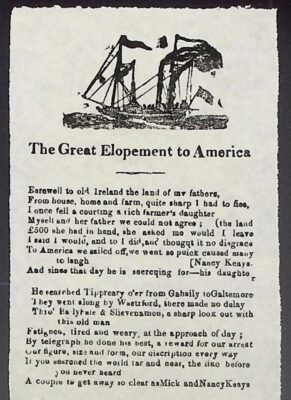
The Great Elopement to America (Pocket 2, no. 69)
In the mid-18th century song books or ballads appeared which consisted of several songs folded into a small pamphlet and sold for a ha’penny, but by the middle of the 1830s, probably because of increasing literacy levels, there was a growing demand for a cheaper way to acquire the songs that were sung on the streets, at fairs and at other public gatherings. The chapmen and ballad-singers began to order single songs, or ‘slips’ from the printer who produced them hastily, cheaply and on poor quality paper and these were then sold on to the crowds wherever they performed. One hundred and sixty-nine of these slips were donated to the Society of Antiquaries by Dr Richard Caulfield FSA; the bulk of the collection in 1866 (“A Collection of Cork Ballads usually sung through the South of Ireland, Miscellaneous, Religious, Elegiac, and Fenian”, Proceedings, November 15th, 1866) and a further set in 1869 (“Twenty-eight Ballads printed in Ireland. (Modern).” Proceedings, November 18th 1869).
Dr Caulfield was a native of Cork and though destined for the church, he was rather more interested in classical studies and antiquity to undertake such a path and so decided to forsake that office for academia and intense study. He became deeply involved with the Cork Cuviarian Society which was the archaeological offshoot of the Royal Cork Institution. It was from the late 1850s onwards that Caulfield began to spend his summers in London researching previously unseen resources relating to Cork and its environs that were to be found at the British Museum, Lambeth Palace, The State and Public Record Offices and the Bodleian Library in Oxford. Caulfield would have become acquainted with the antiquarians and scholars who frequented the exclusive, intellectual circles of the mid-Victorian era, and which would, subsequently, see him made a Fellow of the Society of Antiquarians of London in 1862. The 1860s saw him consolidate his influence upon historical and archaeological scholarship in Cork where he was firstly elected president of the Cuviarien Society and then appointed Librarian of the Royal Cork Institution, a post he held until his death in 1887.
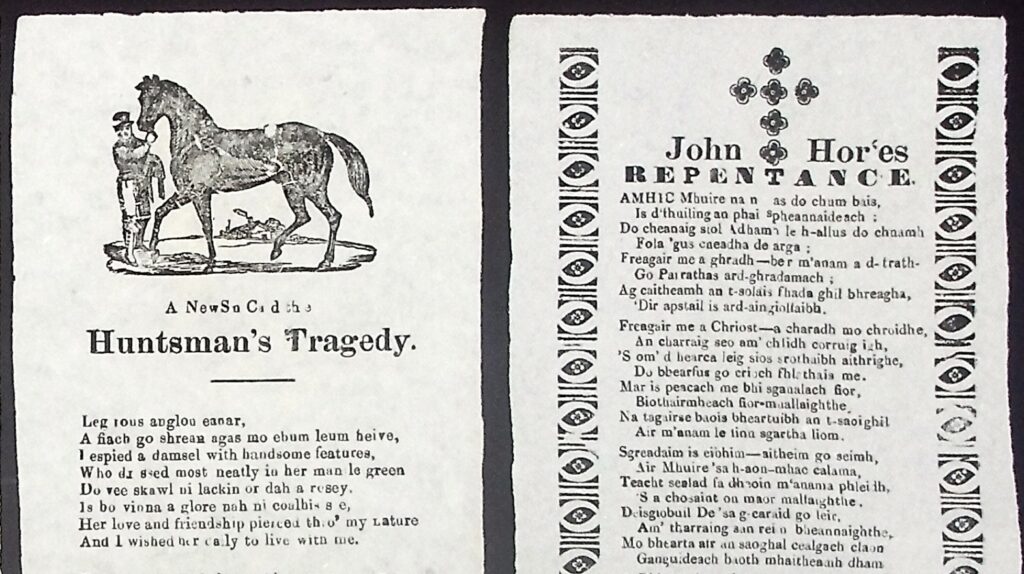
Two ballads mostly in Gaelic (Pocket 2): The Huntsman’s Tragedy (no. 12) / John Hor’es repentance (no. 13)
The name of Haly was synonymous with printing in Cork from around the late 1780s when James Haly, a Roman Catholic, opened his print shop. It is unlikely that his stock in trade was the production of ballads, rather it was probably Joseph Haly (thought to be James’ son) who, from 1834 onwards at the premises in Hanover Street, became one of the first ballad printers in Ireland. Joseph did not shy away from printing seditious or scurrilous content and given the turbulent history of Ireland around these years, it was hardly surprising that he was arrested in 1841 for printing “An Spáilpín Fánach” (the lament of a man evicted by a landowner, who, as an itinerant labourer could not feed his family and so joined the French Army to fight overseas). Currently there is no record of Joseph’s death, but it is certain that Catherine Haly (probably his daughter) was listed at Hanover Street in 1856 and it was she who removed the print shop and its contents to South Main Street sometime during 1857/8. Catherine continued to produce ballads to order until her name drops from the record around 1870.
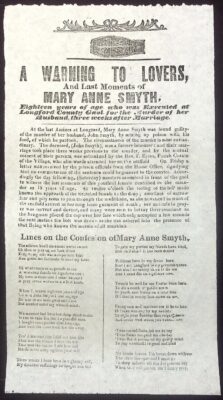
A Warning to Lovers and Last Moments of Mary Anne Smyth …. executed for the murder of her husband (Pocket 2, no. 69)
The collection, as Caulfield donated it, consists of fourteen double slips (across two columns) and some one hundred and fifty-five single column slips. All are in excellent condition given the nature of their construction and use. They are printed upon the poorest quality paper which has not taken the ink well leaving numerous smears and blotches and most of the typesetting is haphazard and at times difficult to read with inverted, misplaced and broken letters. Woodcut illustrations appear at the head of most of the ballads, but they are plainly very old, well-worn, even cracked or broken and, in some cases, riddled with woodworm. The content of the songs covers a range of subjects and is a useful insight into the social culture of mid-nineteenth century Ireland. Catherine’s subject matter is perhaps less contentious than Joseph’s but there are several songs which would have been, nevertheless, quite controversial. There are Riddles, Biographies, Lamentations, Obituaries, Tales of Love, Marriage, Religion, Emigration, America, Shipwrecks, Murder and Execution, which provide a comprehensive list of Catherine’s stock in trade towards the end of her tenure.
We know that Catherine disappears around 1870 and that The Society of Antiquaries received Caulfield’s donations in 1866 and 1869. The few extant copies of Haly prints in other collections show signs of wear and tear, but the pristine physical condition of the slips in the Society’s collection leads us to assume that Caulfield acquired them directly from the print shop, perhaps rescued as Catherine Haly’s business closed.
Note: There has been very little research undertaken into the history of printed ballads in general, even less of those printed in Ireland and certainly by the Haly’s of Cork in particular. The information above was gleaned from the excellent work undertaken by John Moulden who has called for further research on the subject.
References:
McCarthy, J.P. Dr. Richard Caulfield: Antiquarian, Scholar and Academic Librarian. Journal of the Cork Historical and Archaeological Society, Vol XCII, No. 251, January-December 1987.
Moulden, John. The printed ballad in Ireland: A guide to the popular printing of songs in Ireland 1760–1920. PhD, NUI Galway, 2006.
All 169 Cork Ballads are now indexed in the Library catalogue under [Collection of Cork Ballads]. Where identifiable, Bodleian Broadside Ballad numbers and Roud numbers are included for each ballad.
